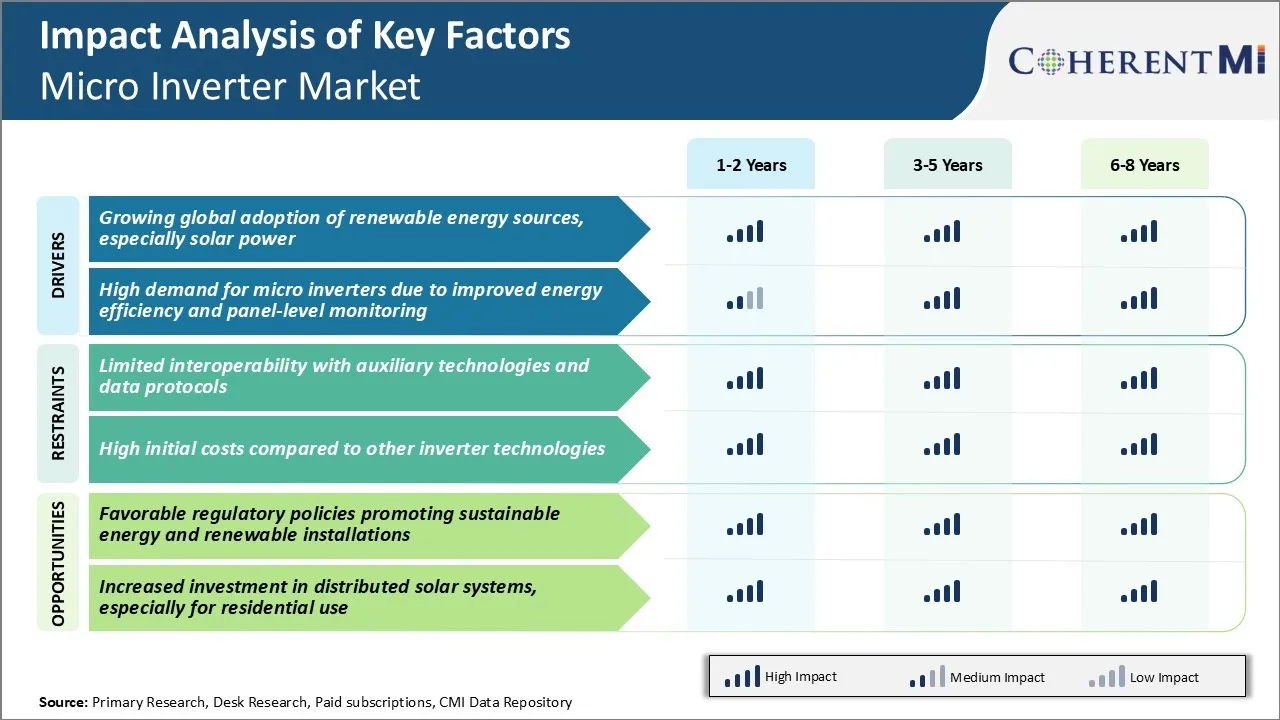Micro Inverter Market Trends
Market Driver - Growing Global Adoption of Renewable Energy Sources, Especially Solar Power
According to estimates, over 180 countries have adopted renewable energy targets and more than 100 countries have renewable energy support policies in place. Solar energy has emerged as one of the most viable and cost-effective renewable option for both large-scale projects as well as rooftop installations.
The rapid capacity additions in solar PV have fueled the demand for associated balance of system components, especially solar inverters that play a critical role in converting the direct current produced by solar panels into alternating current usable by the utility grid or commercial establishments.
The key advantages of micro inverters like module-level monitoring, higher energy yields especially in partial shading conditions, easier installation and maintenance are resonating well with customers. Leading solar installers and some governments have also been promoting module-level power electronics for its reliability and performance benefits. The growing adoption of renewable energy sources globally will thus serve as a key tailwind for the micro inverter market.
Market Driver - High Demand for Micro Inverters due to Improved Energy Efficiency and Panel-level Monitoring
Micro inverters have emerged as a compelling alternative to traditional central and string inverters used in solar installations due to their ability to optimize system performance at the module level. By placing an inverter at the back of each photovoltaic module, micro inverters ensure that each panel operates independently at its maximum power point regardless of the performance of other panels in the array.
Additionally, roof spaces are often limited for larger installations requiring high density packing of solar panels. In such situations, individual module-level maximum power point tracking becomes even more important to extract maximum power from each panel.
Some other advantages like simplified installation without heavy string cables, redundancy to keep producing energy even if one panel fails further strengthen the value proposition of micro inverters. Micro inverters are becoming an essential product choice for residential and commercial rooftop installations. This is significantly driving up the demand growth in the global micro inverter market.

Market Challenge - Limited Interoperability with Auxiliary Technologies and Data Protocols
One of the key challenges currently being faced by the micro inverter market is limited interoperability with auxiliary technologies and data protocols. While micro inverters offer several advantages like module level monitoring and increased system efficiency, their integration with other smart home technologies and protocols has been an area of concern.
Most micro inverters currently work as independent systems and use proprietary communication protocols, limiting their interaction with energy management systems, home automation solutions, storage technologies and other IoT devices. This siloed approach means that homeowners are unable to centrally monitor and control micro inverters along with other smart products on a single platform.
Lack of adoption of open communication standards by micro inverter manufacturers restricts widespread interoperability. This challenge of limited interoperability can negatively impact the future growth potential of the micro inverter market as the integration of distributed energy resources and home automation gains more prominence.
Market Opportunity - Favorable Regulatory Policies Promoting Sustainable Energy and Renewable Installations
The micro inverter market is presented with significant opportunities arising from increasing policy support for sustainable energy and distributed solar installations across various countries and regions. Governments around the world are implementing favorable regulations to incentivize deployment of renewable energy sources in order to meet ambitious climate change goals.
Many national and state/provincial levels policies offer subsidies, tax credits and net metering provisions to homeowners for installing residential solar PV systems. Since micro inverters provide module level power optimization, their adoption is rising among small commercial and residential solar projects that are eligible under such incentive schemes.
Rising public awareness about carbon footprint reduction is also driving demand for localized solar energy harnessing where micro inverters play a crucial role. If supportive regulatory framework and subsidies for distributed energy continue to be strengthened globally, it will drive significant opportunities in micro inverters market in the coming years.